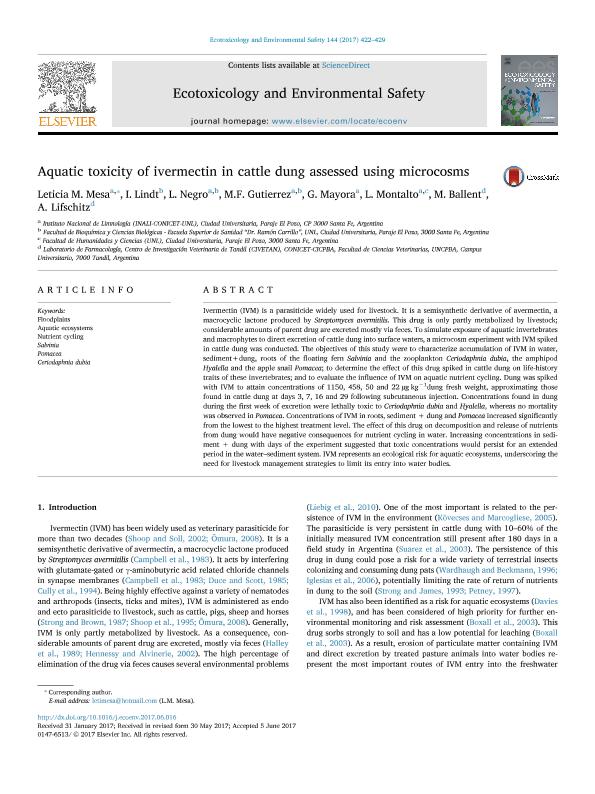Mostrar el registro sencillo del ítem
dc.contributor.author
Mesa, Leticia Mariana

dc.contributor.author
Lindt, I.
dc.contributor.author
Negro, Carlos Leandro

dc.contributor.author
Gutierrez, Marìa Florencia

dc.contributor.author
Mayora, Gisela Paola

dc.contributor.author
Montalto, Luciana

dc.contributor.author
Ballent, Mariana

dc.contributor.author
Lifschitz, Adrian Luis

dc.date.available
2018-11-01T19:05:37Z
dc.date.issued
2017-10
dc.identifier.citation
Mesa, Leticia Mariana; Lindt, I.; Negro, Carlos Leandro; Gutierrez, Marìa Florencia; Mayora, Gisela Paola; et al.; Aquatic toxicity of ivermectin in cattle dung assessed using microcosms; Academic Press Inc Elsevier Science; Ecotoxicology and Environmental Safety; 144; 10-2017; 422-429
dc.identifier.issn
0147-6513
dc.identifier.uri
http://hdl.handle.net/11336/63483
dc.description.abstract
Ivermectin (IVM) is a parasiticide widely used for livestock. It is a semisynthetic derivative of avermectin, a macrocyclic lactone produced by Streptomyces avermitilis. This drug is only partly metabolized by livestock; considerable amounts of parent drug are excreted mostly via feces. To simulate exposure of aquatic invertebrates and macrophytes to direct excretion of cattle dung into surface waters, a microcosm experiment with IVM spiked in cattle dung was conducted. The objectives of this study were to characterize accumulation of IVM in water, sediment+dung, roots of the floating fern Salvinia and the zooplankton Ceriodaphnia dubia, the amphipod Hyalella and the apple snail Pomacea; to determine the effect of this drug spiked in cattle dung on life-history traits of these invertebrates; and to evaluate the influence of IVM on aquatic nutrient cycling. Dung was spiked with IVM to attain concentrations of 1150, 458, 50 and 22 µg kg−1dung fresh weight, approximating those found in cattle dung at days 3, 7, 16 and 29 following subcutaneous injection. Concentrations found in dung during the first week of excretion were lethally toxic to Ceriodaphnia dubia and Hyalella, whereas no mortality was observed in Pomacea. Concentrations of IVM in roots, sediment + dung and Pomacea increased significantly from the lowest to the highest treatment level. The effect of this drug on decomposition and release of nutrients from dung would have negative consequences for nutrient cycling in water. Increasing concentrations in sediment + dung with days of the experiment suggested that toxic concentrations would persist for an extended period in the water–sediment system. IVM represents an ecological risk for aquatic ecosystems, underscoring the need for livestock management strategies to limit its entry into water bodies.
dc.format
application/pdf
dc.language.iso
eng
dc.publisher
Academic Press Inc Elsevier Science

dc.rights
info:eu-repo/semantics/openAccess
dc.rights.uri
https://creativecommons.org/licenses/by-nc-nd/2.5/ar/
dc.subject
Aquatic Ecosystems
dc.subject
Ceriodaphnia Dubia
dc.subject
Floodplains
dc.subject
Nutrient Cycling
dc.subject
Pomacea
dc.subject
Salvinia
dc.subject.classification
Otras Ciencias Biológicas

dc.subject.classification
Ciencias Biológicas

dc.subject.classification
CIENCIAS NATURALES Y EXACTAS

dc.title
Aquatic toxicity of ivermectin in cattle dung assessed using microcosms
dc.type
info:eu-repo/semantics/article
dc.type
info:ar-repo/semantics/artículo
dc.type
info:eu-repo/semantics/publishedVersion
dc.date.updated
2018-10-23T18:15:55Z
dc.journal.volume
144
dc.journal.pagination
422-429
dc.journal.pais
Estados Unidos

dc.description.fil
Fil: Mesa, Leticia Mariana. Consejo Nacional de Investigaciones Científicas y Técnicas. Centro Científico Tecnológico Conicet - Santa Fe. Instituto Nacional de Limnología. Universidad Nacional del Litoral. Instituto Nacional de Limnología; Argentina
dc.description.fil
Fil: Lindt, I.. Universidad Nacional del Litoral; Argentina
dc.description.fil
Fil: Negro, Carlos Leandro. Consejo Nacional de Investigaciones Científicas y Técnicas. Centro Científico Tecnológico Conicet - Santa Fe. Instituto Nacional de Limnología. Universidad Nacional del Litoral. Instituto Nacional de Limnología; Argentina
dc.description.fil
Fil: Gutierrez, Marìa Florencia. Consejo Nacional de Investigaciones Científicas y Técnicas. Centro Científico Tecnológico Conicet - Santa Fe. Instituto Nacional de Limnología. Universidad Nacional del Litoral. Instituto Nacional de Limnología; Argentina
dc.description.fil
Fil: Mayora, Gisela Paola. Consejo Nacional de Investigaciones Científicas y Técnicas. Centro Científico Tecnológico Conicet - Santa Fe. Instituto Nacional de Limnología. Universidad Nacional del Litoral. Instituto Nacional de Limnología; Argentina
dc.description.fil
Fil: Montalto, Luciana. Consejo Nacional de Investigaciones Científicas y Técnicas. Centro Científico Tecnológico Conicet - Santa Fe. Instituto Nacional de Limnología. Universidad Nacional del Litoral. Instituto Nacional de Limnología; Argentina
dc.description.fil
Fil: Ballent, Mariana. Consejo Nacional de Investigaciones Científicas y Técnicas. Centro Científico Tecnológico Conicet - Tandil; Argentina
dc.description.fil
Fil: Lifschitz, Adrian Luis. Consejo Nacional de Investigaciones Científicas y Técnicas. Centro Científico Tecnológico Conicet - Tandil; Argentina
dc.journal.title
Ecotoxicology and Environmental Safety

dc.relation.alternativeid
info:eu-repo/semantics/altIdentifier/url/http://linkinghub.elsevier.com/retrieve/pii/S0147651317303512
dc.relation.alternativeid
info:eu-repo/semantics/altIdentifier/doi/http://dx.doi.org/10.1016/j.ecoenv.2017.06.016
Archivos asociados
